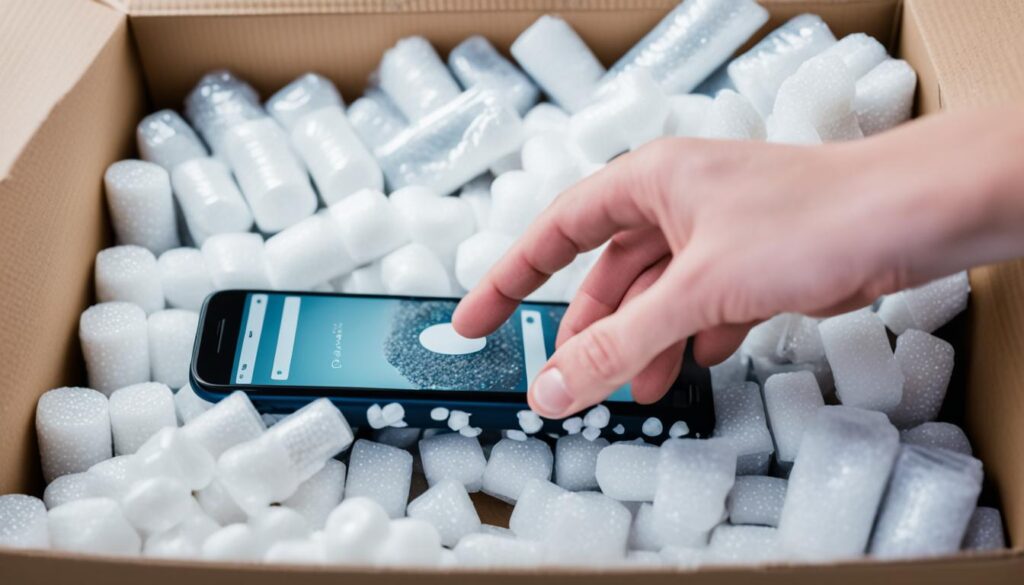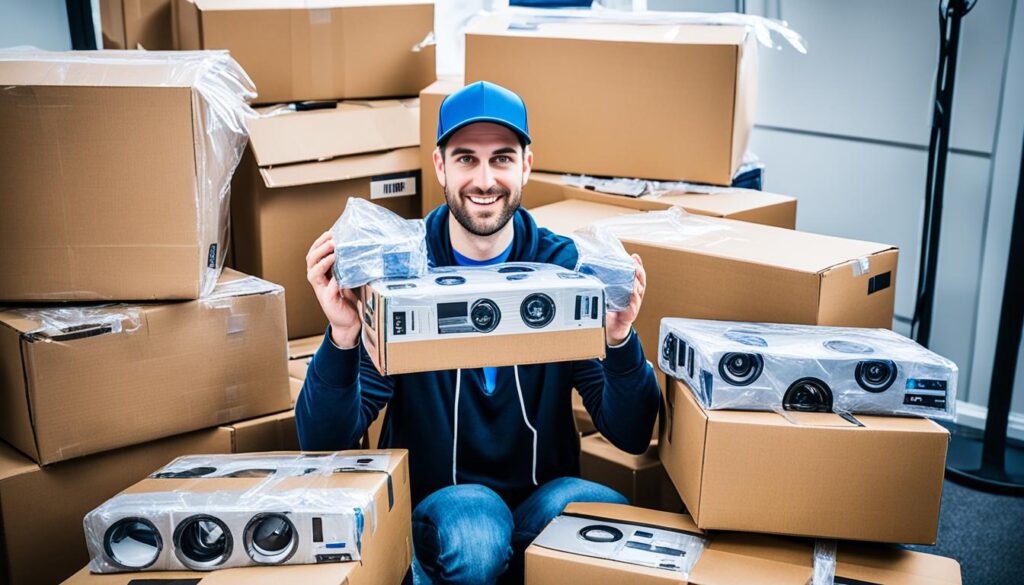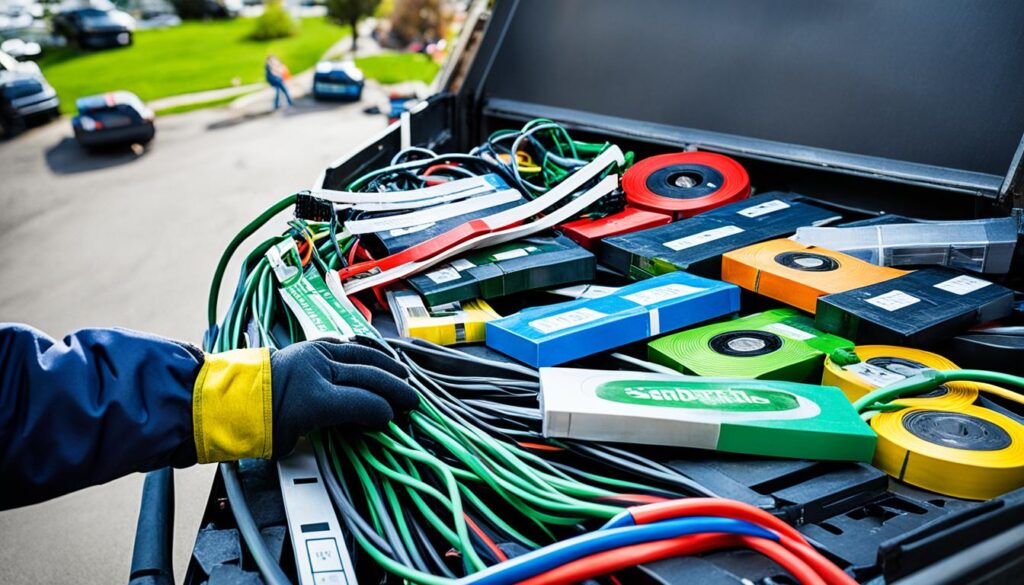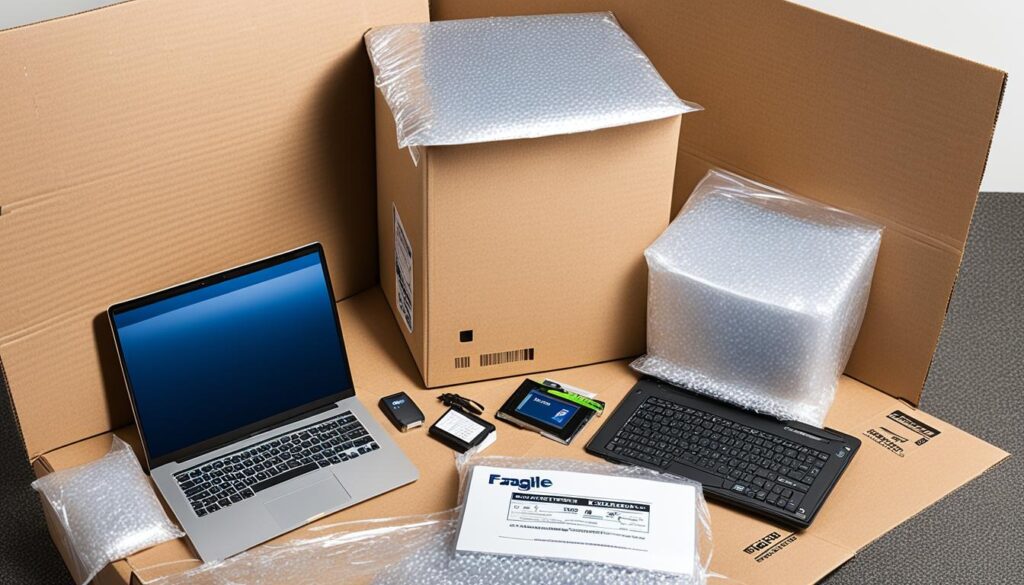Moving can be an exciting and daunting process. Whether you’re relocating to a new home or office, one of the most important things to consider is how to safely transport your electronics. From computers and televisions to gaming consoles and speakers, these devices require special attention to ensure they arrive in perfect condition. In this article, we’ll provide you with essential tips to safely move your electronics, giving you peace of mind during the relocation process.
Key Takeaways:
- Assess your electronics inventory before packing to stay organized.
- Back up important data to prevent loss during the move.
- Gather proper packaging materials, such as bubble wrap and sturdy boxes.
- Disconnect and label cables to make unpacking easier.
- Securely pack your electronics with cushioning and proper labeling.
Assess Your Electronics Inventory
Before you start packing, it’s essential to assess your electronics inventory. Take inventory of all the electronic devices you’ll be moving, including computers, televisions, gaming consoles, speakers, and any other electronics you own.
Creating a comprehensive list of each item and its corresponding cables and accessories will help you stay organized during the packing and unpacking process. This inventory will serve as a reference point when packing your electronics and ensure that nothing gets left behind or misplaced during the move.
As you make your inventory, carefully inspect each electronic device for any existing damage or loose cables. Take note of any repairs or maintenance needed before the move. This way, you can address any issues beforehand and ensure your electronics are in optimal condition for relocation.
Remember, keeping track of your inventory will not only make your move smoother but also allow you to unpack and set up your electronics efficiently in your new location.

Back Up Important Data
Prioritize backing up important data, such as documents, photos, and videos, from your electronic devices. This ensures that even if something gets damaged during the move, you won’t lose valuable information. Use external hard drives, cloud storage, or other backup methods to safeguard your digital files.
Electronic devices store a wealth of important data, from cherished memories to essential documents. Losing this information during a move can be devastating. To protect yourself from potential loss, it’s crucial to back up your important data before relocating your electronics.
One effective method is to use external hard drives or SSDs (Solid State Drives) to create a copy of your files. These portable storage devices provide ample space to store your data and are easily connectable to your computers or laptops. Simply copy and paste your files onto the external drive, ensuring that you have a backup of everything.
Alternatively, cloud storage services offer convenient and secure online backup options. Platforms like Google Drive, Dropbox, and Microsoft OneDrive provide storage space for your files, accessible from any device with an internet connection. Upload your important documents, photos, and videos to the cloud, taking advantage of the peace of mind that comes with remote storage.
When backing up your data, it’s essential to organize your files properly. Create separate folders for documents, photos, and videos to facilitate easy access and management. This way, you can quickly locate specific files when needed.
“Backing up your important data is like buying insurance for your electronic devices. It’s an investment in peace of mind, ensuring that your data remains safe during the relocation process.”
Protect Your Data with Multiple Backups
While one backup is better than none, it’s always wise to have multiple copies of your important files. Consider using a combination of methods to back up your data, such as both an external hard drive and cloud storage. This way, you have multiple layers of protection in case one backup fails or becomes inaccessible.
Test Your Backups
Before moving your electronics, take the time to verify the integrity of your backups. Open a few files from your external hard drive or cloud storage to ensure they are accessible and not corrupted. This simple step can help you avoid surprises and ensure that your data is ready to be restored if needed.
By following these steps, you can safeguard your important data and face the relocation process with confidence. Remember, electronic devices can be replaced, but the data they hold is often irreplaceable. Take the necessary precautions to protect your digital files and enjoy a stress-free move.
Gather Proper Packaging Materials
When it comes to moving your electronics, proper packaging materials are essential to ensure their safety during transportation. By gathering the right supplies, you can protect your valuable gadgets from potential damage. Here are the materials you’ll need:
- Bubble wrap: This provides cushioning and protection for delicate electronics, preventing them from getting scratched or bumped during the move.
- Packing peanuts: These lightweight foam peanuts can be used to fill empty spaces in boxes, reducing the risk of movement and providing additional padding.
- Sturdy boxes: Opt for strong, corrugated cardboard boxes that are appropriate in size for your electronics. Avoid using oversized boxes that may result in shifting or insufficient protection.
- Packing tape: Use high-quality packing tape to securely seal your boxes, preventing them from opening and exposing your electronics to potential damage.
- Ziplock bags: These can be handy for organizing and storing smaller accessories, such as cables, connectors, or screws, ensuring they don’t get misplaced or lost during the move.
By gathering these packaging materials, you can effectively cushion and secure your electronics, minimizing the risk of any damage during relocation.

Disconnect and Label Cables
Before packing your electronics for the move, it’s important to disconnect all cables and cords. This will not only prevent any potential damage during transportation but also make the unpacking process much smoother when you reach your new destination.
How to disconnect and label your cables:
- Gather all the cables and cords belonging to each individual electronic device.
- Bundle them together using zip ties or twist ties to keep them organized and prevent tangling.
- Label each cable with the name of the device it belongs to. This will make it easy to identify and reconnect the cables correctly.
- Consider using color-coded labels or stickers for an even clearer identification.
By disconnecting and labeling your cables, you can save yourself the frustration of trying to figure out what goes where when setting up your electronics in your new home. It’s a simple step that can go a long way in ensuring a smooth and stress-free transition.

Remember: When packing your electronics, be sure to carefully wrap them in bubble wrap or packing paper to provide cushioning and protect them from any potential bumps or impact during the move.
Securely Pack Your Electronics
When it comes to moving your electronics, proper packaging is essential to ensure their safety during the relocation process. Follow these steps to securely pack your electronics and protect them from potential damage.
Step 1: Wrap with Cushioning
Start by wrapping each electronic device in bubble wrap or packing paper. This will provide a layer of cushioning and protect your electronics from impacts or shocks. Pay extra attention to fragile components, such as screens or delicate parts, and ensure they are adequately wrapped for added protection.
Step 2: Choose the Right Box Size
Place your wrapped electronics in appropriately sized boxes. It’s important to choose boxes that are not too big or too small. A snug fit will prevent your items from shifting or moving around during transit.
Step 3: Fill the Gaps
Fill any gaps in the boxes with packing peanuts or crumpled paper. This will prevent your electronics from sliding or jostling during the move. By minimizing movement, you reduce the risk of damage that can occur from internal shifting.
Step 4: Label as Fragile
Once your electronics are securely packed, label the boxes as “fragile” using clear and prominent labels. This will alert the movers and yourself to handle these boxes with extra care. The label should be easily visible on the top and sides of the box to ensure proper handling.
By following these packing guidelines, you can have peace of mind knowing that your electronics are well-protected during the relocation process.
| Electronics Packing Tips |
|---|
| Wrap each electronic device in bubble wrap or packing paper |
| Choose appropriately sized boxes for a snug fit |
| Fill gaps in the boxes with packing peanuts or crumpled paper to prevent movement |
| Label boxes as “fragile” for proper handling |

Seek Professional Help
If you’re unsure about safely packing and transporting your electronics, it’s best to seek professional assistance. Moving companies experienced in handling electronics will have the expertise and equipment necessary to ensure a secure move.
“With delicate electronic devices, it’s crucial to trust the experts. Professionals in the industry have the know-how to handle your valuable gadgets with care, minimizing the risk of damage during the relocation process.” – Mark Johnson, Electronics Moving Specialist
When it comes to electronics moving, safety is paramount. Hiring professionals will provide you with peace of mind, knowing that your valuable devices are in good hands.
Tips for Choosing a Reliable Moving Company:
- Check online reviews and ratings for movers specializing in electronics relocation
- Verify if the moving company is licensed and insured
- Ask for recommendations from friends, family, or colleagues who have recently moved
- Request a detailed quote and compare prices and services offered
Remember, investing in professional assistance will ensure the safety of your electronics and ultimately save you from potential costly damages.
| Pros of Seeking Professional Help | Cons of Seeking Professional Help |
|---|---|
| Expertise in handling delicate electronics | Additional cost for hiring professional movers |
| Specialized equipment for secure transportation | Limited control over the packing and unpacking process |
| Insurance coverage for potential damages | Reliance on the schedule and availability of the moving company |
By weighing the pros and cons, you can make an informed decision on whether seeking professional help is the right choice for you and your electronics.
Carry Electronics with You
When it comes to moving valuable or delicate electronics, such as laptops or high-end cameras, it’s always best to carry them with you instead of packing them in a moving truck. By keeping these items by your side, you have full control over their safety throughout the entire relocation process.
Moving trucks can be subject to unpredictable road conditions and unexpected impacts, which can pose risks to your electronics. By personally handling their transportation, you can ensure that they are protected from any potential damage that may occur during the move.
Carrying your electronics with you allows you to take extra precautions to ensure their safety. You can have them securely placed in a well-padded bag or box, providing an extra layer of protection. Additionally, you can keep a close eye on your belongings, minimizing the chances of accidental mishandling or loss.
Moreover, carrying electronics with you allows you to control the temperature and environment they are exposed to. Extreme temperatures, moisture, and sudden shocks can all negatively impact electronic devices. By keeping them within your immediate vicinity, you can safeguard them from any adverse conditions.
Although it may require a little extra effort, the peace of mind and assurance that your valuable electronics are safe and sound make it well worth the effort.
Handle with Care
When it comes to moving your electronics, handling them with care is of utmost importance. By taking the necessary precautions, you can ensure their safety during relocation.
First and foremost, avoid dropping your electronics at all costs. Even a small fall can cause irreversible damage to delicate components. Prioritize handling them gently and with a steady grip to minimize the risk of accidents.
Additionally, extreme temperatures can have a detrimental effect on electronic devices. Avoid exposing them to direct sunlight or placing them in areas with high heat or cold. Sudden temperature changes can lead to condensation, which can damage internal circuits and components. Keep your electronics in a controlled environment throughout the moving process.
Furthermore, resist the temptation to stack heavy objects on top of your electronics. Excessive pressure can cause internal damage or cracks on the device’s exterior. Always store them in a separate, secure location where they won’t be subjected to unnecessary weight or pressure.
“Handle your electronics as if they were delicate works of art. A gentle touch and proper protection go a long way in preserving their functionality and lifespan.”
Follow these guidelines to ensure your electronics arrive at your new destination unscathed and ready to use.
Note: For more visual appeal, consider including an image of a person gently holding a smartphone or laptop. The alt attribute for the
Set Up Electronics in New Location
Once you’ve arrived at your new location, it’s time to unpack and set up your electronics. Follow these steps to ensure a smooth transition and get your devices up and running.
1. Unpacking
Start by carefully unpacking your electronics from the boxes. Be gentle and avoid rushing to prevent any accidental damage. Remove any packing materials, such as bubble wrap or packing paper, that may have been used to cushion and protect your devices during the move.
2. Reassembly
Refer to the manufacturer’s instructions for reassembling each device. Take your time and follow the provided guidelines to ensure correct and safe reassembly. If you no longer have the instructions, you can often find them online on the manufacturer’s website. Pay close attention to any specific steps or precautions mentioned.
3. Connectivity
Once your devices are reassembled, it’s time to connect them. Make sure all the necessary cables are properly plugged in and secured. Double-check that each connection is firm and stable, as loose connections can cause performance issues or even damage your electronics.
4. Power Up
With everything connected, it’s time to power up your electronics. Switch on each device one at a time and ensure that they are functioning properly. Take note of any error messages, unusual behaviors, or issues that may arise during the startup process. This will help you address any potential problems early on.
5. Testing
Before declaring your setup complete, it’s essential to test each device’s functionality. Use the appropriate controls and settings to verify that everything is working as expected. Test audio and video output, internet connectivity, peripherals, and any other features your devices may have. Be thorough and patient during this testing phase.
By following these steps, you can ensure that your electronics are set up correctly and ready to use in your new location. Take your time and prioritize attention to detail to avoid any potential issues. Enjoy your newly relocated gadgets and make the most of your electronic setup!
Keep Important Documents and Receipts
As you go through the process of relocating your electronics, it’s crucial to keep track of important documents and receipts. This includes warranties, insurance policies, and receipts for expensive devices. These documents serve as valuable evidence in case of any damage or loss during the move.
Having the necessary paperwork can make a significant difference when it comes to filing claims or seeking compensation for any mishaps that may occur during the relocation process. By holding on to these documents, you can ensure a smoother resolution and protect your investment in your electronics.
Remember to store these documents in a safe and easily accessible place. Consider organizing them in a folder or binder labeled “Electronic Documents.” This will help you locate the necessary paperwork quickly in case you need it in the future.
<!–
| Document | Description |
|---|---|
| Warranty | Contains information about the warranty coverage for your electronics. |
| Insurance Policies | Includes details about insurance coverage for your electronics during the move. |
| Receipts | Provides proof of purchase and the value of your electronics. |
–>
Quote:
“Keeping important documents and receipts related to your electronics is essential during the moving process. These papers act as a safety net, providing you with the necessary information and proof in case of any unforeseen circumstances.”
<!–
–>
<!–
Extra Tips:
- Make digital copies of your important documents as a backup. Store them in a secure cloud storage service.
- If you’ve misplaced any receipts, contact the retailer or manufacturer to request duplicate copies.
- Consider taking pictures of your electronics and their serial numbers as additional documentation.
–>
Conclusion
Moving electronics can be a nerve-wracking experience, but with careful planning and execution, you can ensure their safety throughout the relocation process. By following the tips provided in this article, you can minimize the risk of damage and enjoy your devices in your new home.
First, make sure to assess your electronics inventory before packing. Create a comprehensive list of all your devices, cables, and accessories to stay organized. Additionally, prioritize backing up important data to safeguard your valuable information. Utilize external hard drives or cloud storage to ensure nothing is lost during the move.
Gathering proper packaging materials is crucial for protecting your electronics. Use bubble wrap, packing peanuts, sturdy boxes, packing tape, and ziplock bags to provide cushioning and secure them during transportation. Remember to disconnect and label cables to ease the unpacking process.
Consider seeking professional help if you’re uncertain about safely transporting your electronics. Moving companies experienced in handling delicate gadgets can provide the expertise and equipment needed for a secure move. And for valuable or delicate devices, it’s always a good idea to carry them with you to maintain full control over their safety.
With these tips in mind, you can handle your electronics with care and minimize the risk of damage. Arriving at your new location, carefully unpack and set up your devices, ensuring all connections are secure. Lastly, keep important documents and receipts related to your electronics for warranty and insurance purposes.
For more information, assistance, or to explore additional moving services, visit unitedmovingmanagement.com.



